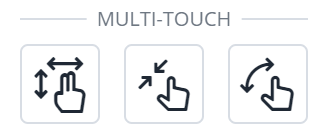Multi-Touch Gesture Tests
In the fast-evolving landscape of touch-based technology, multi-finger gestures have revolutionized user interactions with mobile applications. These intuitive gestures, like swiping, pinching, and rotating with two fingers, play a pivotal role in enhancing user experiences and navigation. To ensure seamless and reliable functionality, thorough testing of these multi-touch gestures is essential.
BitBar offers comprehensive support for testing multi-touch gestures, empowering developers to validate the accuracy and responsiveness of their applications across a diverse range of real devices. With BitBar, developers can confidently deliver exceptional user experiences and ensure optimal performance on various touch-enabled devices.
This page discusses the essential multi-finger gestures - Swipe, Pinch, and Rotate - in the context of mobile and web application testing, focusing on their accuracy and responsiveness to optimize the user experience.
Notice
On iOS devices, multi-touch gestures are recognized and executed only upon the mouse release. This limitation may cause a delay in the application's response while moving around interactive elements during testing.
Prerequisites
Before you start testing multi-touch gestures, visit Getting Started With Live Testing.
Get Started
Open the application on which you intend to test multi-touch gestures.
In the control panel, click one of the following multi-touch gestures:

Tip
Once you select the appropriate gesture, the system displays three objects arranged at the center by default. You can move them around by dragging the inner handle. This way, you can do gestures anywhere on the screen, just like in the real world.
Swipe
The swipe gesture involves dragging one or more fingers across the screen in a horizontal or vertical direction to perform actions such as navigating between screens, dismissing notifications, or scrolling through content.
To test swipe functionality in BitBar, first, click the static inner handle to define whether the swipe should be horizontal or vertical. Next, drag the outer blue handles in the specified direction to perform the swipe test.
Pinch
The pinch gesture involves using two fingers to move them closer together or farther apart on the screen. This action is commonly used for zooming in or out on images, maps, and other graphical elements.
To test pinch functionality in BitBar, first, click the static inner handle to define the diagonal orientation for the pinch – select whether it should be flipped to the right or left. Then, drag the outer blue handles either closer together or further apart to perform the pinch test.
Rotate
The rotate gesture involves using two fingers to perform a circular motion on the screen, allowing users to adjust the orientation of images, maps, and other graphical elements.
To test rotate functionality in BitBar drag the outer blue handles in a circular motion either to the left or right side to perform the rotate test.
Elevate User Experiences through Multi-Touch Gestures
Embrace the power of BitBar's multi-touch gesture testing to create applications that captivate users and set new standards for user satisfaction. With BitBar's support, developers can pave the way for a more engaging and delightful digital world.